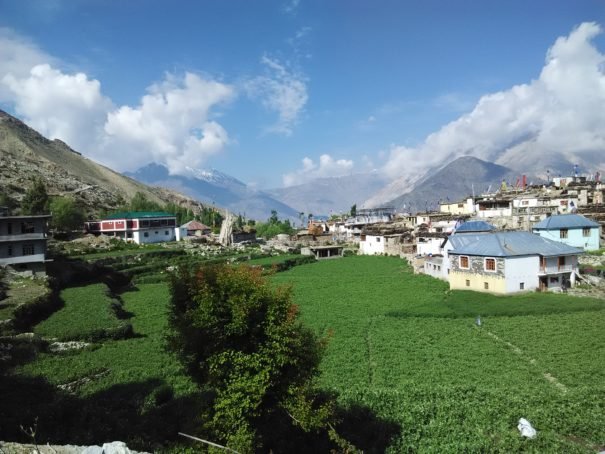
Damn Simple, Dirt Cheap, and Irresistible

Damn Simple, Dirt Cheap, and Irresistible
Tibetan Bread with Jam in Nako
It’s 6:30 a.m. and the chill of high-altitude dawn invades a mom-and-pop restaurant below Loveonn’s Hotel in Nako. Armed with a beanie and a fleece jacket, I’m waiting below posters featuring Lhasa’s Potala Palace, Nepal’s Annapurna mountain range, a smiling Dalai Lama, and a cheeky infant with “this is beauty” scribbled in big serif fonts around his head.
Outside, the main street of Nako—a medieval stone village curled around a 12,000-foot high sacred lake about 20 miles west of the Tibetan border in the Indian state of Himachal Pradesh—is still slumbering. But the Nepali family that mans the restaurant are early risers, and they are already warming up their kitchen to earn today’s first Indian rupees with my breakfast. Tibetan bread: such an exotic name for nothing more than a hot, round piece of flat bread.
I pick it out of the breakfast section of a one-page, laminated and misspelled menu, between the evergreen egg omelette and Israeli shakshuka. Tibetan bread is so irresistible because it’s damn simple, not as greasy as most other Indian breakfasts, and dirt cheap (only 50 Indian rupees, slightly more than 50 cents). It’s perfect for this morning, as I’m heading out to a stupa-flecked mountain to climb an five-mile path that should get me to a mysterious “Tibet View Point.” Tibet: I’ll have a peek on the forbidden part of China from a soaring 13, 000 feet in the air. The globalizing strawberry jam that comes with the bread may not sound super authentic, but it will certainly help me stock up on the calories I need.
This corner of Upper Kinnaur is nestled right below the Buddhist Spiti Valley, and thrives by exporting thousands of pounds of green beans to the lower valleys of Himachal Pradesh. Between the 15th and 17th century, it was at the confluence of the kingdoms of Ladakh, Central Tibet, Bashahr and the Guge of West Tibet. Today, Nako sits right across one of the world’s most uncertain borderlands, at the top of the high-altitude table where Asian superpowers China and India have been arm-wrestling since the Dalai Lama fled to India in 1959. Beautiful ancient Tibetan paintings don the walls of a simple monastery where a young monk performs a one-man puja every evening at 6 p.m.
It’s here and along the Spiti Valley to the northeast that a mash-up of Tibetans, Nepali, and Hindus gather in the summer, exploiting the tourist season and earning for the harsh, desolate winter ahead. Maybe the Tibetan bread with jam is the region’s simple answer to intruders, a welcome and a farewell that symbolizes the blend of tradition and trickling tourism-induced globalization.
“Enjoy your food,” says the Nepali daughter who, speaking English, is always sent out of the kitchen by mom and dad to take care of foreigners. Last night she saw me shudder in a gush of cold wind, typical even in August. “In October we close everything and go back to Lumbini,” she said. “It’s too cold here to do anything here.”
But right now, my Tibetan bread steams from the plate she places before me, melting a smutter of strawberry jam into reddish liquid. My fingers enjoy the fresh-off-the-pan warmth of the bread’s surface, its semi-burnt bumps and thick outer crust. As I rip it in half from top the bottom, the heat inside steams upwards, fogging my glasses. Still visually challenged, I cut a chunk of jello-jam and use a knife to douse it inside the warm bun before taking my first hungry bite.
It’s a sensorial overload, a mix of crunchy hot and chemically-sweetened nothingness that’s also the farthest thing from strawberry I’ve ever tasted. I lift up my gaze as I keep munching, and the Dalai Lama is still smiling from the opposite wall. I’m lucky, because by mixing the mystic bread with such globalized profanity I still haven’t broken the calm surface of his ocean of compassion.